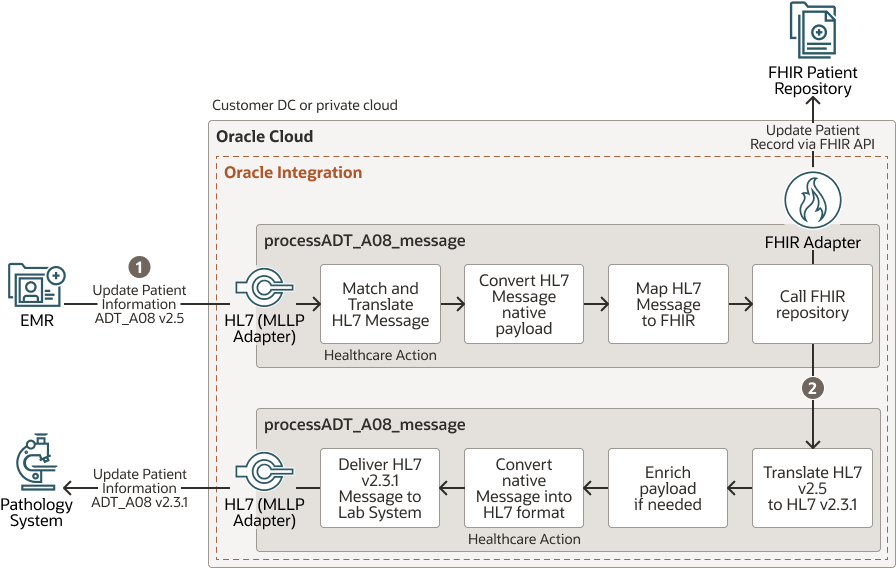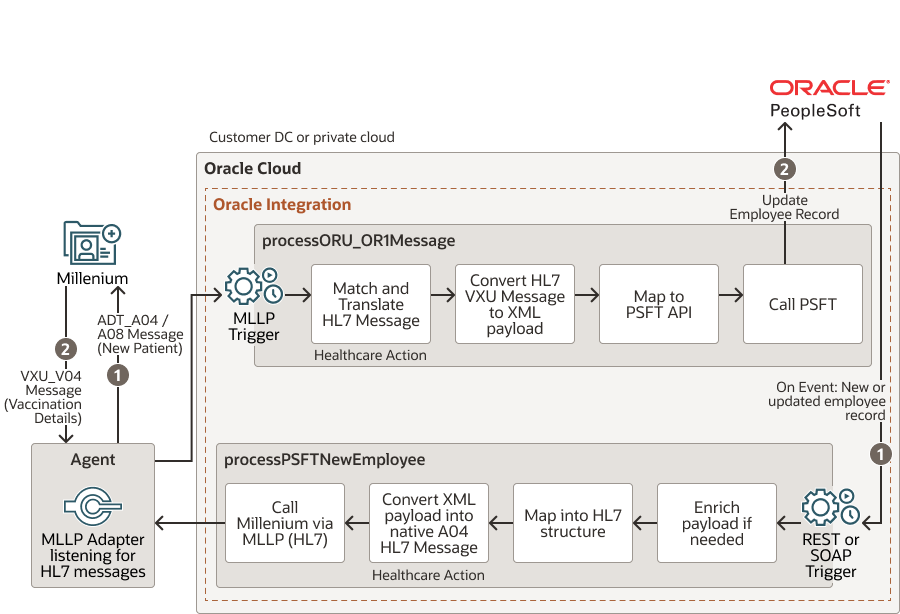Quick Tour Through Oracle Integration for Healthcare Use Cases
This section provides high level overviews of several Oracle Integration for Healthcare use cases.
Synchronize EMR Patient Updates in a FHIR Patient Repository and a Pathology System
This use case describes how an update to patient details in an employee medical record (EMR) application is automatically propagated to a FHIR patient repository and a pathology system through use of Oracle Integration for Healthcare.

- Patient details are updated in an EMR, which emits an HL7 ADT_A08 message. The message is received by Oracle Integration and converted to a FHIR patient resource for updating in a FHIR-enabled patient repository.
- The integration continues and Oracle Integration translates an HL7 message from version 2.5 to version 2.3.1 and sends it to a pathology system for updating the patient records.
EMR Application Patient Updates
- A doctor updates details about a patient (for this example, a change in name) in an EMR application. The updates are performed through use of an HL7 Update Patient Information message (ADT_A08). The EMR application uses HL7 version 2.5.
- The EMR application emits the updated HL7 ADT_A08 message.
- An MLLP Adapter running inside the connectivity agent and configured as a trigger connection in an integration receives the incoming message for processing.
- The HL7-formatted message is converted into an XML-formatted message by a healthcare action in the integration.
The following updates are automatically made in parallel in the FHIR patient repository and the pathology system:
FHIR Patient Repository Updates
- The XML message is converted into a JSON-formatted, FHIR patient resource in the integration.
- The FHIR patient repository
is invoked with the FHIR Adapter.
Based on the type of patient, the following updates are
applied in the FHIR repository:
- For an existing FHIR repository patient: The patient is updated with the name change made in the EMR application.
- For a new patient: All patient details are added to the FHIR repository.
Pathology System Updates
Because the pathology system uses an earlier version of HL7 (2.3.1), the message must be down-versioned from 2.5 to 2.3.1 for the message to be successfully processed.
- The ADT_A08 message is:
- Converted from XML format back to HL7 format by a healthcare action in the integration.
- Down-versioned from HL7 version 2.5 to version 2.3.1.
- The MLLP Adapter running inside the connectivity agent and configured as an invoke connection sends the down-versioned, HL7-formatted message to the pathology system, where the patient details are updated.
Synchronize Employee Information Between an HR Application and an EMR Application
This use case describes how a new employee hire added to a human resources (HR) application is also automatically added as a patient in an employee medical record (EMR) application. When this employee later receives a vaccination, the update made to the EMR application is automatically propagated back to the HR application.

- Start of onboarding a new employee. A new employee event is sent to Oracle Integration, converted to an HL7 message, and sent to Mellennium.
- Start of a new or updated employee vaccination record. A new HL7 vaccination message event is sent to Oracle Integration, converted to Oracle PeopleSoft format, and sent to Oracle PeopleSoft.
HR Application Employee Updates Synchronized in an EMR Application
- An HR application (for this example, Oracle PeopleSoft) stores information about their employees (for example, date of hire, job title, compensation details, and so on).
- An EMR application (for this example, Mellennium) stores internal health records pertinent to employee jobs (for example, employee vaccination records, employee allergy records, and so on). The EMR application uses HL7.
The following actions occur:
- A new employee is hired and added to the HR application.
- The HR application update triggers a REST Adapter connection to start an integration between the HR application and the EMR application.
- The HR application message is converted to an HL7-formatted, ADT_A04 message (patient registration) by a healthcare action in the integration.
- An MLLP Adapter running inside the connectivity agent and configured as an invoke connection sends the outbound message to the EMR application at Acme Hospital.
- The ADT_A04 message (patient registration) is automatically added to the EMR application. The new employee is now available in both applications.
EMR Application Employee Updates Synchronized in the HR Application
Acme Hospital employees must periodically receive various vaccinations, allergy tests, and so on.
- An Acme Hospital nurse administers an employee's annual vaccination and updates their medical record in the EMR application.
- The EMR application emits an HL7 ORU_OR1 message (vaccination details message).
- An MLLP Adapter running inside the connectivity agent and configured as a trigger connection in a second integration receives the incoming message for processing.
- The HL7-formatted message is converted into an XML-formatted message by a healthcare action in the integration.
- A REST API call invokes the HR application and the employee's records are updated to reflect their vaccination details.